Stream
Stream is a personal computer that's separated into six wireless modules. Users purchase any or all of the modules, depending on their requirements from a computer. That could be consuming Media like music and movies, or staying Connected through the internet or email.
This modular design allows the product to adapt to any situation: with all the modules sitting together at home, users get the full capability of a personal computer. But for music on the go, all they need to take is the Media module. No longer do users have to purchase a second product (iPod) to do what a current one (laptop) already does. Nor do they have to lug a whole computer around, when they only want to use it for one or two functions.
When users need more power for demanding at-home tasks, such as gaming or video processing, they can purchase extra RAM or CPU which connect wirelessly to the modules.
By solving this function and component duplication, along with add-on upgrades, Stream proposes a far more sustainable solution to modern computing devices.

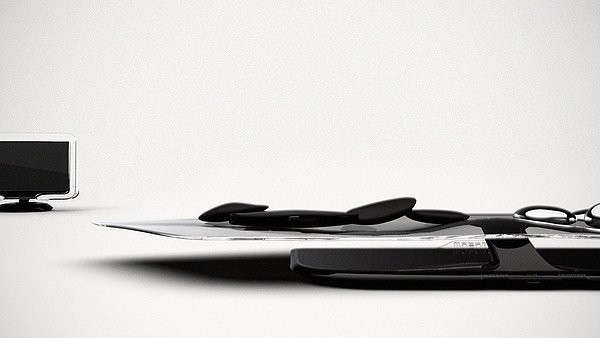
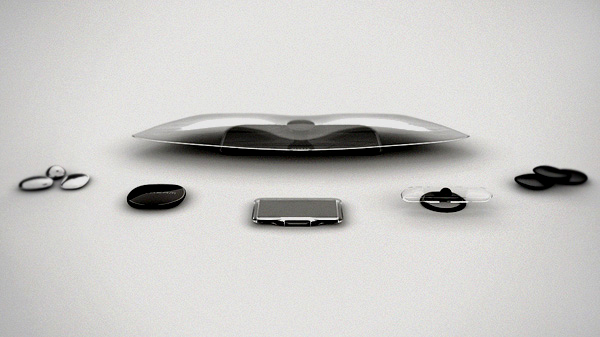

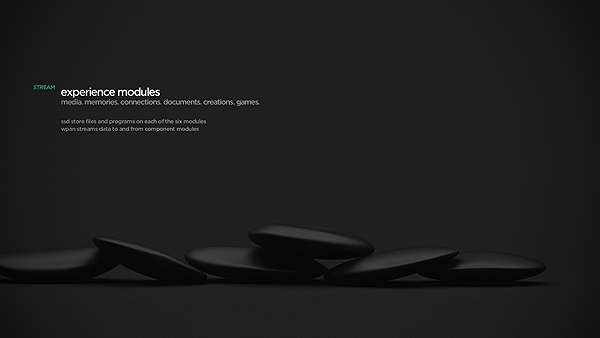
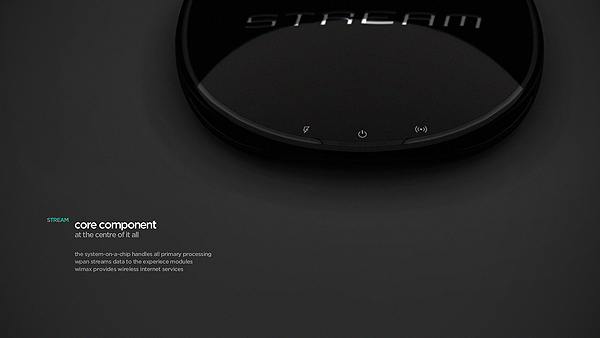
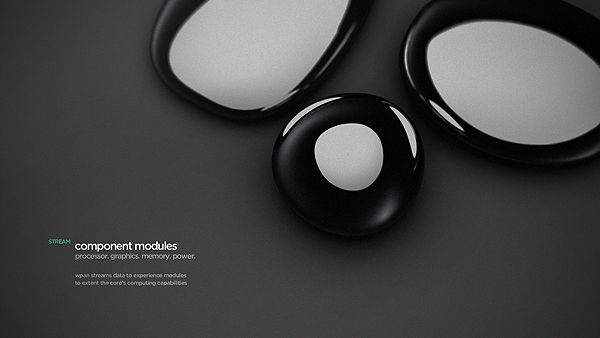
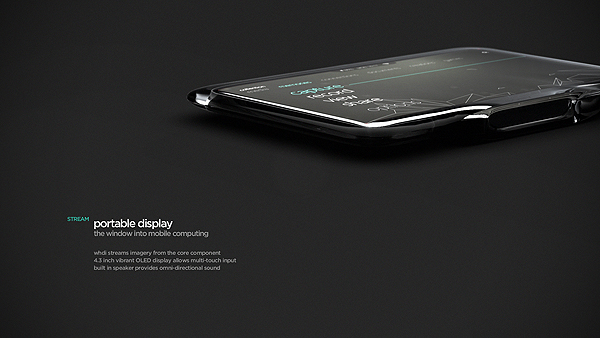
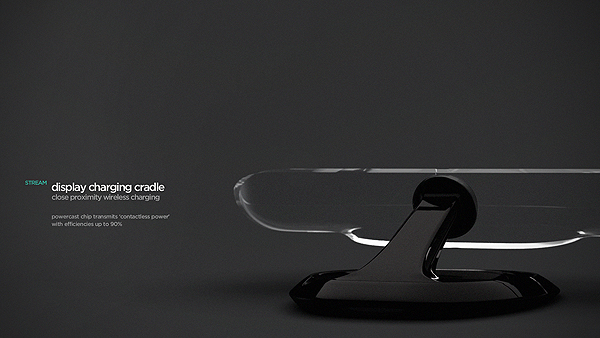
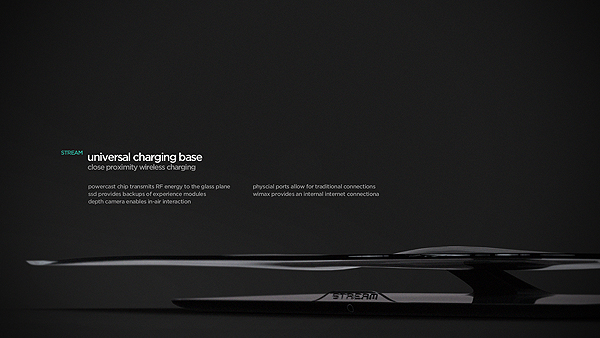
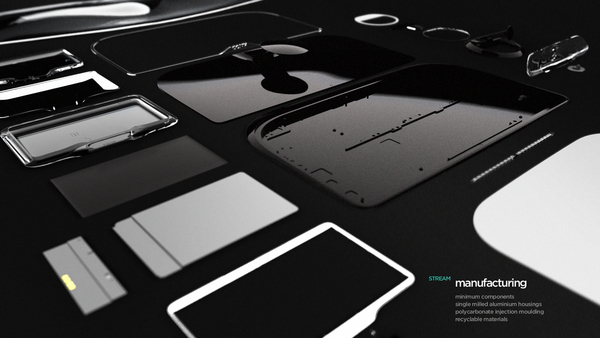
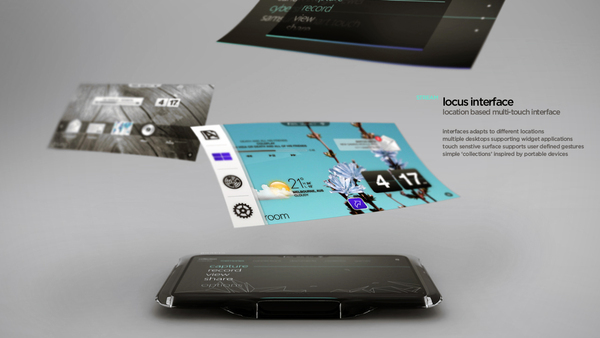
In Depth
The Stream concept consist of Experience Modules (Media, Memories, Connections, Documents, Creations, Games), the Core Component, Component Modules (processors, memory, graphics, power), a 3.5” Portable Display and Charging Cradle and Universal Charging Base. The former three are paramount to the system, while the latter three are non-essential or functionally flexible. By developing this modular system, the designer has created many advantageous features over current products.
Firstly is the idea that people can have only what they need, when they need it. This is due to the distinct separation of a computer’s functions into six categories called ‘experiences’. Currently, if a user wishes to purchase a computer purely for documenting and internet they must accept that it will come with processing power and features well beyond these needs. With the Stream concept, however, users would purchase only the Connections and Documents modules as well as the Core Component to perform only these functions. The Connections module also acts as a phone, which leads to the second benefit of this system.
Many users today are faced with both an overlap of functions, content and components. In the previous example, the user’s computer would be capable of making calls through VOIP (a technology most likely to overtake traditional GSM networks), however there is no way of taking this one component of the machine with them. Instead, they must purchase another product - a phone - to fulfill this need. But now they have two devices capable of making calls, browsing the internet, emailing and taking photos as well as two interfaces to learn. Another example is how users have music on both their computer and a portable device such as an iPod. Multiply this over the abundance of consumer products we possess, and the problem worsens exponentially. However because of the Experience Modules and the adaptive nature of Stream, this issue is eradicated. The device they use at home or the office is the same device they use in the car or on the bus. All that changes is the screen size and possibly the addition of Component Modules.
The Component Modules are just as important to the system as the Experience Modules. Users who require greater processing power for activities such as gaming or high end design, still purchase the Core Component but also the necessary Component Modules to meet their needs. The Experience Modules are designed relative to their function. For example the Games and Connections modules have far more complex logic boards, capable of wireless connections to more powerful processors. This ensures that the price of the system is fair across all desired functions or experiences.
The Stream adaptive computer system is more portable and expandable than current systems, it offers a more natural and personal experience for the user and is more environmentally friendly in doing so. It can be an ultra-portable laptop, camera-phone, or games console. It is what the user wants it to be.
Product breakdown:
Experience Modules:
- Solid state drive ranging from 50GB - 1TB
- Logic board to handle and organize the data processed by the Core and Component Modules
- Contain personal files and software for specific experiences
- Media: music, movies, images, digital tv, digital radio
- Memories: photos, videos, social networking integration. Designed to use with camera
- Connections: VOIP, internet browser, email, social networking, GPS
- Documents: word processing, data spreadsheets, presentations
- Creations: 2d design, 3d modeling, video production, animation
- Games: console, portable
Core Component:
- Primary processing unit with system-on-a-chip
- Connects to Experience Modules via WPAN
- Connects to screens/TVs via WHDI
- Stores OS and core services- WiMax for internet services
- GPS for location services
Component Modules:
- CPUs, GPUs, RAM
- Provide extra computing power
- Connect to Experience Modules via WPAN
- Necessary for tasks usually undertaken at home of office ie creative design or gaming
- Most likely left on Charging Base at all times
Portable Display:
- 4.3" OLED screen
- Omni-directional speaker
- Multi-touch support
- Streams imagery from the Core Component via WHDI
Portable Display Cradle:
- Wirelessly charges display via Powercast's 'contactless power'
Universal Charging Base:
- Charges all components on glass plane with Powercast's RF energy
- Backs up data from Experience Modules
- Features depth camera to enable in-air interaction with a connected screen/TV
- Syncs with Core Component and transmits imagery to screen/TV via HDMI
- WiMax for internal internet services
Locus OS:
- Location-based operating system
- Multiple widget desktops designed around a location or activity ie Kitchen, Office, Car
- Automatically switches between desktops with GPS and wi-fi mapping
- Simplified Collections menu allows browsing via function rather than application


